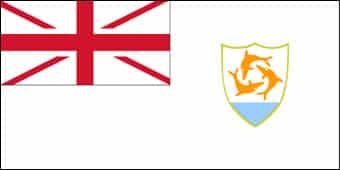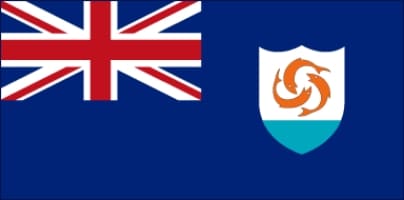
About Flag of Anguila
On May 30, 1990, the present Anguilla flag was formally adopted. Since 1957, the nation has flown five different flags. The British Union Jack flag and a shield are placed in the top left and right corners, respectively, of the blue Anguillan flag. On the flag’s lower right corner is the coat of arms. Three orange dolphins are shown on a white backdrop with blue water below.
The dolphins are a symbol of power, camaraderie, and wisdom.
Since it is a British Dependent Territory, the nation’s flag is the British Flag.
The flag has a 1:2 ratio.
Historical Background
The current design of the Anguilla flag was adopted on May 30, 1990, but its origins can be traced back to the island’s historical struggle for self-determination and separation from its former political association.
| Official Name: | Anguilla |
| Proportion: | 1:2 |
| Adopted on: | May 30, 1990 |
| Location of the country: | Eastern Caribbean, east of Puerto Rico and the Virgin Islands |
| Capital City: | The Valley |
| Major Cities: | Sandy Ground, Ebenezer, Saint Mary’s, White Hill |
| Area: | 35 square miles |
| Population: | 15,295 (2022 estimate) |
| Currency: | East Caribbean dollar (XCD) |
| Official Language: | English |
| National Anthem: | God Save the Queen |
| National symbol(s): | dolphin |
| National anthem: | |
| Name: | “God Bless Anguilla” |
| Lyrics/Music: | Alex RICHARDSON |
Design and Colors
The Anguilla flag features a blue field with the British Union Jack in the canton, representing the island’s historical ties with Great Britain. Centered on the blue field is the Anguillan coat of arms, which consists of three dolphins leaping out of the sea. The dolphins symbolize friendship, wisdom, and strength.
Symbolism of the Anguilla Flag
The colors and symbols on the Anguilla flag hold significant meaning. The blue color represents the surrounding Caribbean Sea and the tranquility and serenity of the island. The British Union Jack signifies Anguilla’s historical association with Great Britain and its status as an overseas territory. The three dolphins in the coat of arms symbolize the unity, harmony, and resilience of the Anguillan people.
Usage and Protocol
The Anguilla flag is proudly flown on public buildings, private residences, and businesses throughout the island. It is hoisted on national holidays, official ceremonies, and events to signify Anguilla’s identity and unity. The flag should be treated with respect and dignity, and it is customary to raise and lower it ceremoniously.
National Symbols Day
Every year on July 1st, Anguilla celebrates National Symbols Day. This day is dedicated to honoring and promoting awareness of the island’s national symbols, including the Anguilla flag. Festivities, cultural events, educational programs, and exhibitions are held to celebrate the significance of these symbols in Anguillan history and culture. More Info
FAQs
Q1: When was the current design of the Anguilla flag adopted?
The current design of the Anguilla flag was adopted on May 30, 1990.
Q2: What does the British Union Jack represent on the Anguilla flag?
The British Union Jack on the Anguilla flag represents the island’s historical ties with Great Britain as an overseas territory.
Q3: What do the three dolphins in the coat of arms symbolize?
The three dolphins in the coat of arms symbolize friendship, wisdom, and strength, representing the unity and resilience of the Anguillan people.
Q4: When is National Symbols Day celebrated in Anguilla?
National Symbols Day is celebrated in Anguilla on July 1st each year.
Q5: What is the significance of National Symbols Day?
National Symbols Day is dedicated to honoring and raising awareness of Anguilla’s national symbols, including the Anguilla flag, and celebrating their importance in the island’s history and culture.

